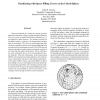Free Online Productivity Tools
i2Speak
i2Symbol
i2OCR
iTex2Img
iWeb2Print
iWeb2Shot
i2Type
iPdf2Split
iPdf2Merge
i2Bopomofo
i2Arabic
i2Style
i2Image
i2PDF
iLatex2Rtf
Sci2ools
80
Voted
IPPS
2003
IEEE
2003
IEEE
Partitioning with Space-Filling Curves on the Cubed-Sphere
Numerical methods for solving the systems of partial differential equations arising in geophysical fluid dynamics rely on a variety of spatial discretization schemes (e.g. finite difference, finite element). For parallel execution on distributed memory computers, the computational domain must be partitioned. The choice of partitioning algorithm can have a significant impact on the sustained floating point execution rate of an atmospheric model. The NCAR spectral element atmospheric model employs a gnomonic projection of a cube onto the surface of the sphere. The six cube faces are each subdivided into an array of quadrilateral spectral elements. When the cubed-sphere is partitioned using METIS, both computational load imbalance and communication requirements can lead to sub-optimal performance. In this paper, Hilbert, Peano, and nested Hilbert m-Peano space-filling curves are investigated as the basis of alternative partitioning algorithms. The resulting partitions allow a maxim...
Distributed And Parallel Computing | IPPS 2003 | Partitioning Algorithms | Point Execution Rate | Spectral Elements |
| Added | 04 Jul 2010 |
| Updated | 04 Jul 2010 |
| Type | Conference |
| Year | 2003 |
| Where | IPPS |
| Authors | John M. Dennis |
Comments (0)

